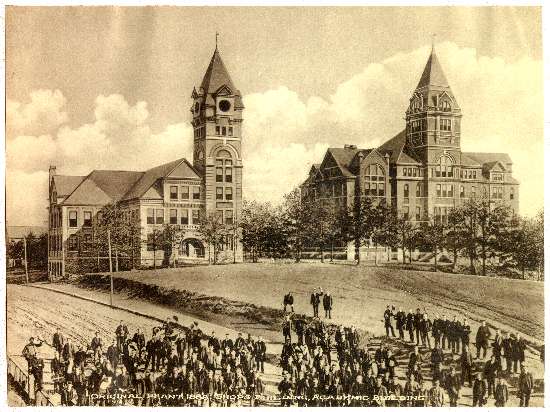 |
GTVA-OVZ-700-A
Location:
T171 .G42 G49x GTVA-OVZ-700-A
Title: Date:
Original plant 1888: Shops Building, Academic Building
Unknown
Content:
Adhesive on reverse side of print with paper fibers where print removed from paper backing.
History:
This photograph shows the first two buildings of the Georgia School of Technology--the Academic and Shop Buildings. The Academic Building
and the original Shop Building, both erected in 1888, were designed by the Architectural Firm Bruce and Morgan, according to the lofty high
Victorian tenets popularized at the time by John Ruskin. Buildings modeled after Ruskinian principles were heroic and ornate in design,
embued with the concept that civic and industrial activities were steeped in moral purpose. This photograph shows the first Shop Building,
which was destroyed by fire on April 21, 1892. The dramatic focal points for both buildings are their towers, which were similar in size
and appearance and reflected the school's intent to focus equally on the Shop, or learning by doing, and on academic learning. A committee
was appointed in 1882 to study the feasibility and requirements of a school of technology in the state of Georgia. The committee visited
successful technical education establishments in the North. According to Warren Drury in his master's thesis, the committee discovered
two divergent educational philosophies: the shop culture, exemplified by schools such as the Worcester Free Institute in Massachusetts
and the school culture, as practiced by schools such as the Massachusetts Institute of Technology. "Shop schools" were modeled on the
apprenticeship program and focused on teaching a useful and practical trade as the foundation
for the educated, successful industrialist. The "school culture" emphasized the academic underpinnings of industry: higher mathematics,
theoretical science and original research. The committee decided that the Georgia School of Technology would place equal emphasis on
practical apprenticeship and academic pursuits. According to Drury, the Worcester Free School was selected as the model for the Georgia
school because the committee felt it offered the best model "for moral as well as practical reasons." The Georgia School of Technology was
expected to do more than
teach academic subjects or a trade. The role of the school was also to develop in the state's youth "the character traits of industry, or
diligent attention to work." The committee was also impressed by the self-sufficiency of Worcester. "Items made in the shop by Worcester
students were sold to produce income for the school." $65,000 was appropriated for grounds and buildings, tools and appliances, for
school operation for one year. Peters Park was selected, over competing sites in Grant Park and on Boulevard, for reasons of cost and best
proximity to Atlanta business, railroads and
industry. The first campus of the Georgia School of Technology was nine acres and two buildings in the area bounded by North Avenue,
Fowler Avenue, and Cherry Street. The most prestigious civic architectural firm in Atlanta--Bruce and Morgan--was selected to design the
first two buildings, an academic building containing classrooms, laboratories and administrative offices and a shop building containing a
foundry, forge, boiler room and engine room, to support the learning of wood work and metal work, with a view to designing and building
working engines. The Shop Building also served as the school's physical plant.
The Annual Catalogue of the Georgia School of Technology Announcement for 1888-89 described the Academic Building as "a splendid edifice
a was designed in the same "high Victorian" style as the
portant component of Georgia
Tech culture. President Hopkins purchased "machines which were made of glass, reserving to be made in the machine shop those constructed
l machine shop was awarded
the contract for heating for the Academic Building. Heating was produced and installed at cost: $1,444.68.